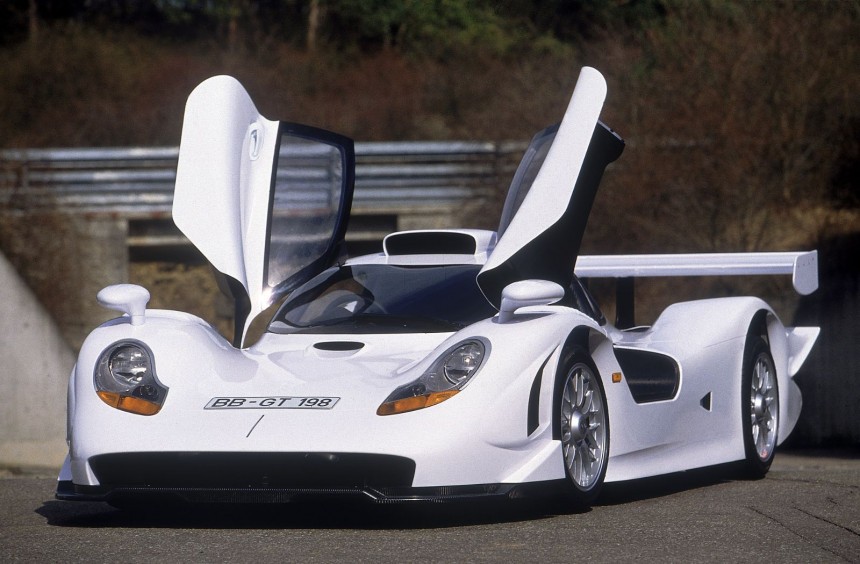The short-lived yet spectacular era of GT1 racing gave birth to some wild road-legal homologation specials such as the Mercedes CLK GTR or the Porsche GT1. The latter is the wildest vehicle built by Zuffenhausen-based carmaker during the 1990s, and arguably the most extreme road-worthy 911 of all time.
In the mid-1990s, Porsche wanted to re-establish itself as the dominant force in endurance racing. In the BPR Global GT Series - the world’s premier endurance competition - Porsche was present with various production-based racecars since the series debuted in 1994. However, none could challenge the BMW-powered McLaren F1 GTRs.
At Le Mans, they managed to win in 1994 with the factory-backed Dauer 962 by exploiting a loophole in the regulations. The governing body modified the guidelines a year later, effectively banning the Dauer-Porsche from the famous race which was won by an F1 GTR.
By the end of 1995, it was clear that in order to get back on top, Porsche needed a new, McLaren-slaying GT1 machine. The man tasked with developing it was none other than the legendary Norbert Singer, who was given just a few months to deliver.
While all other GT1 cars at the time were based on production models, Singer went in the opposite direction and created the racer first. It was basically a combination between a modified version of the venerable 962’s rear section and a new front end that resembled the 993-generation 911. Built around a tubular steel chassis with a pushrod suspension in the front, it was powered by a water-cooled, twin-turbocharged flat-six mounted midship. An evolution of the 962’s powerplant, the 3.2-liter could produce around 590 hp.
In addition to the racecars, two street-legal prototypes were built for homologation purposes. Fitted with road car features like functional headlights, taillights, turn signals, or two seats, both were sent to the German Federal Ministry of Transport, Building, and Urban Development for compliance testing.
These two cars with 993 style headlights and taillights are considered the first iterations of the Straßenversion (Street version, in German). Both have survived to this day and are now part of private collections.
Their race siblings were completed in time for Le Mans, where one of them won the GT1 class and finished second overall behind the Joest Racing TWR Porsche WSC-95, open-top prototype. That car also took part in the last four races of the 1996 BPR season, earning three wins.
In the meantime, Singer and his team of engineers were already working on a revised version of the GT1 racecar in preparation for the upcoming season. The carbon fiber bodywork featured several visible modifications that were meant to improve aerodynamics. It now came with headlights and taillights from the all-new 996 generation of the Porsche 911 which would be unveiled in 1997.
Powered by the same engine as its predecessor, the upgraded car dubbed 911 GT1 Evolution proved to be faster than the previous version during initial tests. Unfortunately for Porsche, it was plagued by reliability issues in the inaugural season of the FIA GT Championship (the former BPR), where Bernd Schneider and his new Mercedes CLK GTR finished first overall, ending the McLaren F1’s reign of dominance.
Things didn’t end well at Le Mans either. Two GT1 Evolution cars were entered by the works team, and both failed to finish. After 24 hours, the Joest Racing TWR Porsche WSC-95 chassis from 1996 saw the checkered flag first, defending its title, while a 1996-spec 911 GT1 raced by Schübel Engineering crossed the finish line fifth.
Porsche managed to compete with the new GT1 since 1996 because of a clause that permitted manufacturers to race even if they had not built the required 25 road cars, as long as they would deliver them by the end of the following year. So, despite the disastrous results of the 1997 season, the Germans had to go ahead with the planned production run of the Straßenversion.
Heavily based on the race car, its suspension was altered for increased ground clearance while the engine was de-tuned to 536 hp to meet European emissions standards. Porsche also redesigned the interior which donned a 996 dashboard, full-leather bucket seats, a stereo, and an air conditioning system. These modifications made the road-going version a bit heavier, but it could still accelerate to 62 mph (100 kph) from a standstill in 3.9 seconds on its way to a top speed of 194 mph (312 kph).
Speed aside, it wasn’t built just for homologation purposes. Even though it was a racer let loose on public roads, it retained the Porsche DNA and behaved like one. Carfection performed a group test of the street-legal McLaren F1, the Mercedes-Benz CLK GTR, and the Porsche 911 GT1 last year. The three-part series can be found on YouTube and you can watch the one dedicated to the 911 below. Henry Catchpole drove the monster around and he was quickly amazed by how well it maneuvered, comparing it to a meaner 911 that felt controllable at any moment, rather than a full-blown race car that requires a lot of skill and courage to tame.
Twenty examples were sold to the public, each going for $912,000 ($1,584,220 today). The majority were painted in Artic Silver or Fern White, whereas three owners ordered their cars in bespoke colors.
Aided by an overhaul of the FIA GT1 class regulations that required just one street version to be built for homologation, Porsche went back to the drawing board for the 1998 season. Not only did they improve the design and fix most of the issues that led to the disastrous 1997 campaign, but ended up building a completely new car.
Known as the GT1-98, it used a new carbon-fiber monocoque chassis that improved rigidity and lowered the weight by around 30%. On top of it sat a redesigned body that was closer to Le Mans prototype spec than the GT1. The front suspension setup was also overhauled, and the twin-turbo engine was fitted with a TAG 3.8 engine management system that replaced the troublesome Bosch unit. With about 550 hp on tap, it didn’t improve in terms of power, but it was mated to a new sequential gearbox that improved shift times.
The car didn’t do very well in the FIA GT Championship, as Porsche’s crosstown rivals Mercedes won every single race with their improved CLK LM. However, the story was different at the legendary 24-hour race where the two GT1-98s combined for an epic 1-2 finish.
As I mentioned earlier, the rules required manufacturers to build a single road car. Finished in white, the GT1-98 Straßenversion was nearly identical to the racecar, save for a different suspension setup, minor interior details, and a custom rear wing. It was kept by Porsche and can be admired in the company’s museum.
The list of road-worthy versions is completed by the 911 GT1 Evolution. This lesser-known car started life as an early, 1996-spec racer that was used by a private team in 1997 until it was seriously damaged. The chassis was repaired, and it received a new GT1 Evo body from Porsche and continued to compete until 2001. It was sold to a collector who had it completely restored in 2014. He managed to register the vehicle for road use in the UK, which makes it the only street-legal GT1 racecar and the only one that features an engine that wasn’t de-tuned. The unique example was sold in 2016 at an RM Sotheby’s auction for $2.7 million.
At Le Mans, they managed to win in 1994 with the factory-backed Dauer 962 by exploiting a loophole in the regulations. The governing body modified the guidelines a year later, effectively banning the Dauer-Porsche from the famous race which was won by an F1 GTR.
By the end of 1995, it was clear that in order to get back on top, Porsche needed a new, McLaren-slaying GT1 machine. The man tasked with developing it was none other than the legendary Norbert Singer, who was given just a few months to deliver.
While all other GT1 cars at the time were based on production models, Singer went in the opposite direction and created the racer first. It was basically a combination between a modified version of the venerable 962’s rear section and a new front end that resembled the 993-generation 911. Built around a tubular steel chassis with a pushrod suspension in the front, it was powered by a water-cooled, twin-turbocharged flat-six mounted midship. An evolution of the 962’s powerplant, the 3.2-liter could produce around 590 hp.
These two cars with 993 style headlights and taillights are considered the first iterations of the Straßenversion (Street version, in German). Both have survived to this day and are now part of private collections.
Their race siblings were completed in time for Le Mans, where one of them won the GT1 class and finished second overall behind the Joest Racing TWR Porsche WSC-95, open-top prototype. That car also took part in the last four races of the 1996 BPR season, earning three wins.
In the meantime, Singer and his team of engineers were already working on a revised version of the GT1 racecar in preparation for the upcoming season. The carbon fiber bodywork featured several visible modifications that were meant to improve aerodynamics. It now came with headlights and taillights from the all-new 996 generation of the Porsche 911 which would be unveiled in 1997.
Things didn’t end well at Le Mans either. Two GT1 Evolution cars were entered by the works team, and both failed to finish. After 24 hours, the Joest Racing TWR Porsche WSC-95 chassis from 1996 saw the checkered flag first, defending its title, while a 1996-spec 911 GT1 raced by Schübel Engineering crossed the finish line fifth.
Porsche managed to compete with the new GT1 since 1996 because of a clause that permitted manufacturers to race even if they had not built the required 25 road cars, as long as they would deliver them by the end of the following year. So, despite the disastrous results of the 1997 season, the Germans had to go ahead with the planned production run of the Straßenversion.
Speed aside, it wasn’t built just for homologation purposes. Even though it was a racer let loose on public roads, it retained the Porsche DNA and behaved like one. Carfection performed a group test of the street-legal McLaren F1, the Mercedes-Benz CLK GTR, and the Porsche 911 GT1 last year. The three-part series can be found on YouTube and you can watch the one dedicated to the 911 below. Henry Catchpole drove the monster around and he was quickly amazed by how well it maneuvered, comparing it to a meaner 911 that felt controllable at any moment, rather than a full-blown race car that requires a lot of skill and courage to tame.
Twenty examples were sold to the public, each going for $912,000 ($1,584,220 today). The majority were painted in Artic Silver or Fern White, whereas three owners ordered their cars in bespoke colors.
Known as the GT1-98, it used a new carbon-fiber monocoque chassis that improved rigidity and lowered the weight by around 30%. On top of it sat a redesigned body that was closer to Le Mans prototype spec than the GT1. The front suspension setup was also overhauled, and the twin-turbo engine was fitted with a TAG 3.8 engine management system that replaced the troublesome Bosch unit. With about 550 hp on tap, it didn’t improve in terms of power, but it was mated to a new sequential gearbox that improved shift times.
The car didn’t do very well in the FIA GT Championship, as Porsche’s crosstown rivals Mercedes won every single race with their improved CLK LM. However, the story was different at the legendary 24-hour race where the two GT1-98s combined for an epic 1-2 finish.
As I mentioned earlier, the rules required manufacturers to build a single road car. Finished in white, the GT1-98 Straßenversion was nearly identical to the racecar, save for a different suspension setup, minor interior details, and a custom rear wing. It was kept by Porsche and can be admired in the company’s museum.
The list of road-worthy versions is completed by the 911 GT1 Evolution. This lesser-known car started life as an early, 1996-spec racer that was used by a private team in 1997 until it was seriously damaged. The chassis was repaired, and it received a new GT1 Evo body from Porsche and continued to compete until 2001. It was sold to a collector who had it completely restored in 2014. He managed to register the vehicle for road use in the UK, which makes it the only street-legal GT1 racecar and the only one that features an engine that wasn’t de-tuned. The unique example was sold in 2016 at an RM Sotheby’s auction for $2.7 million.























